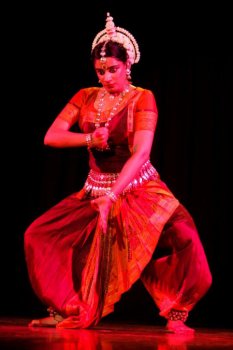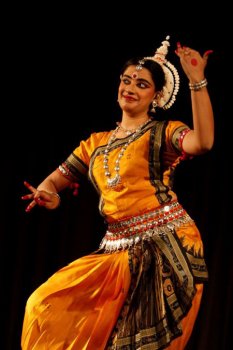
|   |

|   |
Odissi exponent Barkha Tanvir shows promise - Dr. Sunil Kothari e-mail: sunilkothari1933@gmail.com Photos: Avinash Pasricha June 10, 2013 Barkha Tanvir is a disciple of Odissi exponent Anita Babu, who was trained at Orissa Dance Academy of late Guru Gangadhar Pradhan at Bhubaneswar and is a contemporary of Nandita Patnaik, Aruna Mohanty and Bichitrananda Swain. Anita also studied from them and along with them. In 1997, she established Odissi Nrityashala in Mayur Vihar, New Delhi. I saw Barkha Tanvir at Bhubaneswar during International Odissi dance festival for the first time. She hails from the renowned family of Nemichandra and Rekha Jain from her mother Kirti Jain’s side. Kirti Jain is an SNA awardee director from National School of Drama. Barkha displayed talent for classical dance and started studying from Anita Babu. In a program titled Udaya, Barkha gave an interesting recital at India International Centre on 5th June 2013. She has a good stage presence and an expressive visage. Accompanied by well known Oriya musician Sukanta Kumar Kundu for vocal, Pradeepta Kumar Maharana on mardala, flute by Saumya Joshi and violin by Sajiv Kunda, Barkha performed Mangalacharan followed by pure dance sequence based on rhythmic variations and sculpturesque poses. The sabdaswarapata like recitation of the text described veena vadini, playing upon veena, suggestive poses of Bhujang shayan, asleep on serpent Shesha, Garuda vahana, astride Garuda bird, Kandarpa nayaka, handsome as Kamadeva and so on interspersed with ukutas, mnemonic syllables and with catchy rhythm of thai thaii tahat ta tak thai and moving in a circle with quick steps, Barkha gave ample evidence of her involvement and execution of varied movements. There seemed an easy flow of movements form one phrase to another. The choreography was by late Guru Gangadhar Pradhan. Barkha attempted to present it with sincerity 

In Oriya pada “Na ja Jamuna lo sahi” choreographed by Bichitrananda Swain, Radha is warned by her sakhi not to go to Jamuna, where none else but Lord Krishna with his divine beauty would charm her away and she would be lost. But the nayika does not pay heed to such warnings as she is anxious to see the Lord. Rendered with feeling by Sukanta Kundu, it gave scope to Barkha to portray subtle nuances of lajja, shyness and innocence in abhinaya. In Rageshree pallavi, a gem of pure dance choreographed by Guru Gangadhar Pradhan and set to music by Ram Hari Das, one saw Barkha executing the movements in slow tempo which gained momentum as it progressed. Whereas the sculptural poses like Darpani, looking in a mirror, parshva mardala, playing on mardala on side, were performed with ease, overall impression created was that of need for saushthavam, and taut body position when coming to refrain and chowka poses. Barkha would do well to overcome this lacuna with conscious attempt and more practice, for the body with its very stance and upright strong posture would help her for transition from one movement phrase to another, giving the necessary tautness for dance. Her postures are correct, but they appear less energetic and weak. Barkha concluded her performance with Mahakali Stutee evoking the benign and ferocious aspects of the Goddess who is Durga, wielding khadga, chakra, gada, chap, has various ornaments adorning her, she is Mahalakshmi and so on. Barkha used her eyes to register the ferocious expressions, but the delicate ones were executed in contrast with gentle expressions. She needs to invest her stances with more vigour and energy to bring out both conflicting aspects of the Goddess. Barkha shows promise to be a competent Odissi exponent and with passage of time and more exposure she should make the grade.  Dr. Sunil Kothari is a dance historian, scholar, author and a renowned dance critic. He is Vice President of World Dance Alliance Asia Pacific India chapter, based in New Delhi. He is honored by the President of India with Padma Shri, Sangeet Natak Akademi award and Senior Critic Award from Dance Critics Association, NYC. He is a regular contributor to www.narthaki.com, the roving critic for monthly magazine Sruti and is a contributing editor of Nartanam for the past 12 years. |